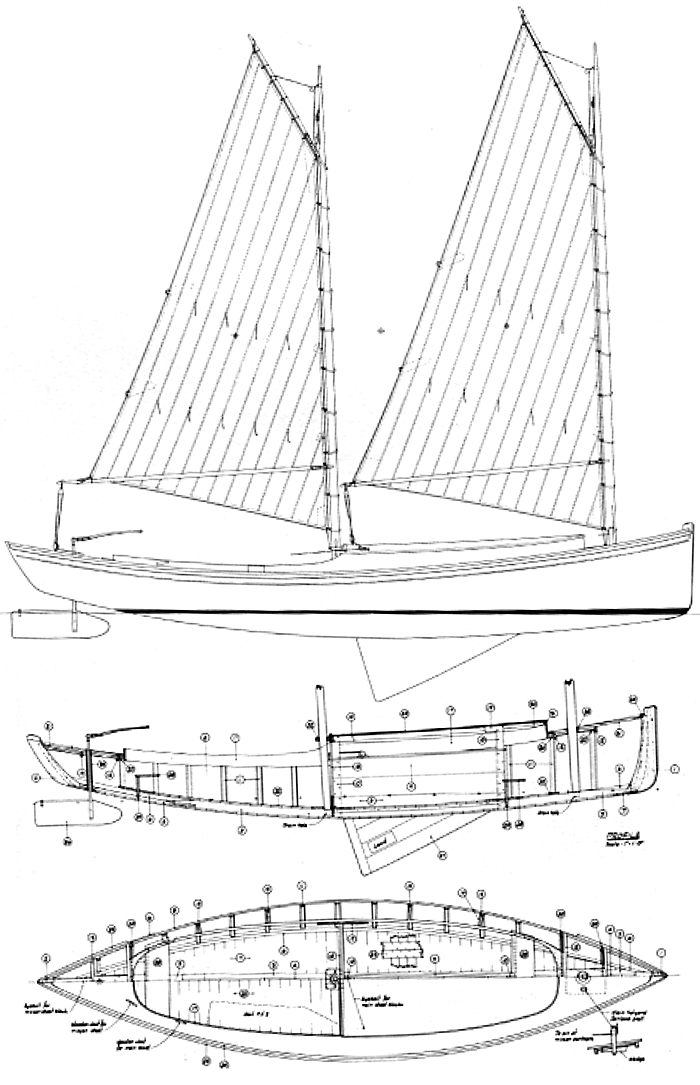Sharpie 600
Senast uppdaterad den 1 februari 2025, 169 kommentarer
Bilder | Specifikationer | Mer om | Bakgrund och historia
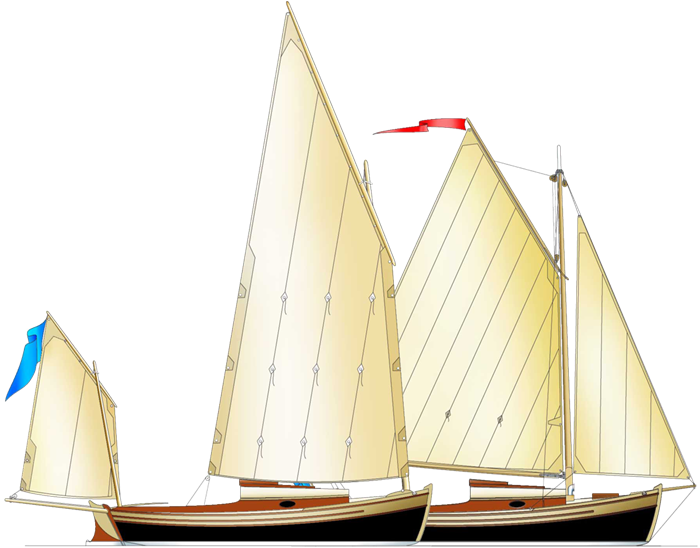
Ritningssats, Sharpie 600 - 6 200 SEK
Beställ
Sharpie 600 är ritad som en lätt, snabb och bekväm segelbåt för dagsturer och kortare övernattningsturer - så som de flesta båtar faktiskt används, oavsett vad konstruktörerna egentligen har tänkt sig. Så här ser kravspecifikationen ut:
- Dagseglare för många.Rymlig sittbrunn (2 meter) för 1-6 personer. Bekväm under segel och i hamn. Roder och skot inom räckhåll utan att passagerare är i vägen. Med loggertriggen finns ingen bom över sittbrunnen. Den kränger också mindre i vindbyar genom att masterna är ostagade och flexar vid vindpress.
- Turbåt för två.Bekvämt beboelig för en, acceptabel för två, även i dåligt väder. Fast kök och vask. Två kojer och mycket stuvutrymmen. Plats för portabel toalett. Möjlighet till uppvärmning under tidig vår och sen höst.
- Snabb nog för rejäla dagsetapper. Mycket segelyta (SA/d = 21) för att inte vara beroende av motor i lätta vindar. Loggertriggen är den snabbare på läns, slör och halvvind. På kryss är skillnaden försumbar.
- Säker. Självrätande vid kapsejsning. Lätt att reva med bibehållen balans (loggertriggen är helt balanserad i alla kombinationer), vilket tillsammans med ett barlastförhållande på nära 50% gör att båten är hanterbar även i besvärliga förhållanden.
- Liten och grundgående.Kort, smal och lätt (d/l = 159) för att vara lätt att hantera på och av en båtkärra och för att minimera eller eliminera hamnavgifter. Hon sticker bara 22 cm med roder och centerbord uppfällda. Det går att segla ända in till stranden eller övernatta på en sandbank vid lågvatten. Vid en grundstötning går roder och centerbord upp utan att skadas. Den låga vikten gör att den kan torrseglas från en båtkärra för den som inte har eller vill ha hamnplats. Hon kan med båtsläp och en vanlig personbil byta skärgård på några timmar, och kan stå hemma i trädgården över vintern.
- Traditionellt vacker med lågt skrov och markerat språng. Kan manövreras lätt och elegant för segel eller för motor (eller varför inte för åror?). Framför allt erbjuder loggertriggen manövermöjligheter som enmastade båtar aldrig kan matcha.
- Minimalt underhåll.Modern torr träkonstruktion, plywood-epoxy-glasfiber. Inga fasta installationer. Utombordsmotor i urtag i akterspegeln (alternativt kan en liten inombordsmotor få plats under ett kort bridgedäck). Elmotor och ett batteri kanske?
- Lätt att hantera.All hantering på land eller i vatten skall vara möjlig att klara för en ensam person. Med gaffelrigg fäller man snabbt och lätt masten för passage under en bro.
- Lätt att bygga.Båten är ritad för amatörbygge och byggs av 7 tvärgående och 2 längsgående plywoodskott som skjuts ihop i sågade spår som ett pussel. På detta limmas bordläggning, däck och botten av plywood. Ytan skyddas med glasfiberväv för att bli underhållsfri.
Sharpie 600 vann tredje pris i Classic Boats designtävling 1996
...och hade det inte varit för det obrittiska tilltaget att placera centerbordet och d:o mesanmasten off-center, hade jag kanske kommit 1:a! Men där passerade jag gränsen för vad gammal brittisk båttradition kan tåla och the stiff upper lip darrade av harm över sådan frivolitet.
En kort videofilm om en segeltur med S/Y Kuling i Norge (Audun Bulls sajt om S/Y Kuling)
Ett proffsbygge i Frankrike.
A video clip of S/Y Kuling sailing in the south of Norway. (Audun Bull´s website on S/Y Kuling)
Riggalternativen
Sharpieritningerna visar antingen loggertrigg eller sluprigg (gaffel) och detta måste alltså specificeras vid beställning. Båda riggarna är lite ovanliga numera, men passar mycket bra på centerbordsbåtar med litet djupgående. Att båda riggarna var vanliga förr beror dels på att de är enkla att hantera, kräver mindre teknisk utrustning (vinschar och sådant) och går att segla med mycket liten besättning (en liten båt som sharpien seglas naturligtvis komfortabelt av en person oavsett riggtyp). Här är en kort beskrivning av dem.
Gaffelriggad slup

På gaffelriggen sitter masten i ett tabernakel (som i ett gångjärn), vilket innebär att den är lätt att fälla ner (t ex för att komma under broar). Eftersom de flesta som seglar eller har seglat är vana vid enmastade segelbåtar, kan det vara enklare att komma igång med gaffelriggen (även om få moderna båtar har gaffel). Gaffeln är ett sätt att få större segelyta på en kortare mast och därmed mindre vikt till väders (genomgående lattor är en modern variant av samma idé). Gaffelriggen medger att storseglet tas ner eller revas utan att båten ligger i vindögat (släpp på klo- och pikefall så ligger seglet på rufftaket oavsett vindriktning). Gaffelriggen tappar en aning i effektivitet dikt bidevind mot en modern rigg men vinner i gengäld i halvvind, slör och läns.
Loggert
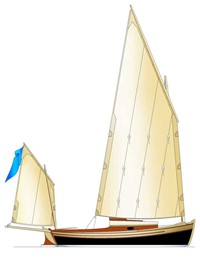
Loggertriggen är en äldre typ av rigg, som har flera fördelar: Det finns ingen bom som man kan få i huvudet vid en jipp. Man kan stå rak i sittbrunnen utan att få seglet i ansiktet. Det är lättare att precisionsmanövrera för segel (gira, segla åt sidan in till en kajplats, backa etc) med två master än med en. Loggertriggen är ostagad, vilket innebär att masterna kan böja sig lite i vindbyar och spilla vind, så att båten kränger mindre. Loggertmasterna är lättare och är lätta att lyfta i och ur för hand (men inte lika enkla att snabbt fälla som gaffelmasten).
Från början ritade jag loggertrigg på sharpien, för att jag är rätt van att segla loggert (se kanotyawlen) och uppskattar fördelarna. Men många intresserade byggare kände sig tveksamma inför en så arkaisk rigg och jag fick många förfrågningar om ett alternativ. Så jag ritade en gaffelslup. Av sålda ritningar (drygt hundra fram till juni 2021) har hittills ungefär två tredjedelar varit gaffel och en tredjedel loggert – jag har förstått att många väljer gaffel av estetiska skäl, för ett de tycker att det ser mer "skeppsmässigt" ut.
Specifikationer

| Längd |
600 cm |
| Bredd |
206 cm |
| Djupgående |
22/122 cm |
| Vikt |
600 kg |
| Segelyta |
21 m2 |
| Inredning |
2 kojer, pentry med vask, vattentank och kokplattor, toalett (portabel), förvaringsutrymmen |
| Höjd i ruffen |
128 cm (vid spant 5) |
| Rek. motorstyrka |
6-12 HP |
| Användningsområde |
Dagturer för 1-6 personer. Långtur för 2 personer. |
Om ritningar och bygge
Sex ritningblad rymmer den information som behövs för att bygga en sharpie – i alla fall för den som har lite vana: exempelvis byggt en kajak:
1. Linjeritning
2. Konstruktionsritnin
3. Sektioner
4. Profilritning
5. Inredning
6. Rigg, master och segel
OBS! Specificera vid beställning om du vill gaffel- eller loggertversionen.
Sharpien byggs i plywood – ett enkelt och snabbt sätt att få upp styrka och finish. Men det går även bra att bygga botten av spontade brädor. Båten behöver en stadig plattform att "stå på" (gå på grund eller segla in till stranden) och rekommendationen på ritningen är dubbel 12 mm
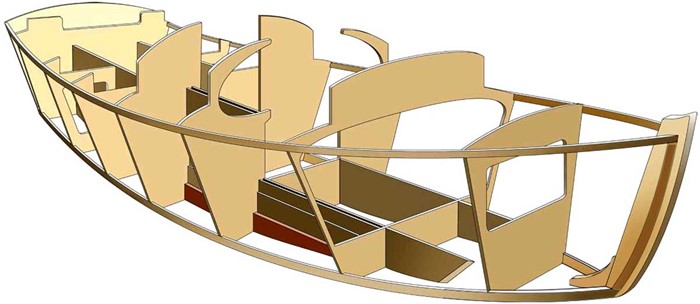
Plywoodpanelerna sågas ut och skjuts ihop som ett 3D-pussel till en stabil enkompononentsstruktur. Fogarna kan vara antingen träribb och skruv eller hålkälsspackling med epoxy/glasfiber. Barlasten är blyskivor som gjuts av kasserade däckvikter (blyet kan smältas till exempel med hjälp av grillkol och gjutas på en spånskiva med påspikade läkt – utomhus! och stå inte i vindriktningen). Bilden visar loggertversionen.
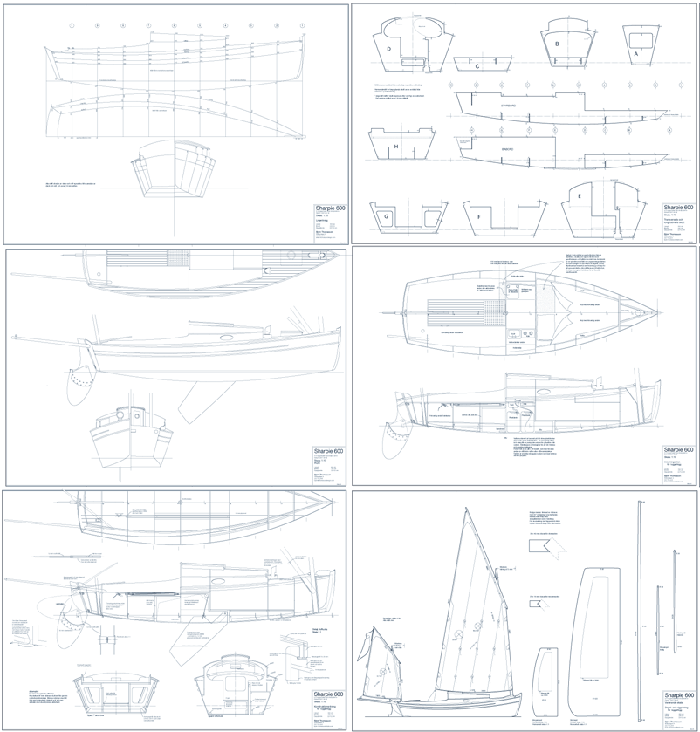
Ingen separat byggbeskrivning medföljer. Den som behöver mer information kan komplettera med någon av de båtbyggeriböcker som finns i litteraturlistan.
Ritningssats, Sharpie 600 - 6 200 SEK
Beställ
Mer om Sharpie 600
Jag får många frågor om centerbordet. Det sitter ca 30 cm till höger om centerlinjen - helt dolt bakom skottet till pentryt och sittbrunnsbänken. Det innebär att man slipper den centerbordtrumma som brukar förvandla inredningen i de flesta små centerbordsbåtar till två trånga och tämligen oanvändbara krypin. Det är förvånansvärt rymligt i Sharpie 600.
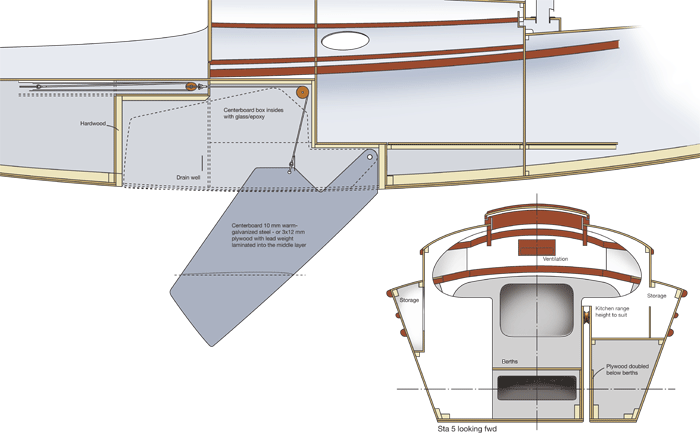
"Men seglar hon inte bättre på ena bogen?" I praktiken skall det mycket stor seglingsvana för att överhuvudtaget märka någon skillnad. Förr satt de flesta centerbord offcenter - båtbyggare tyckte inte om att såga hål i kölen, utan satte centerbordstrumman genom bordläggningen vid sidan om. Därför följer Sharpien bara gammal vedertagen tradition.
Sittbrunnen är på ritningen inte självlänsande. Den som seglar i förhållanden där självläns är önskvärt kan höja durken några centimeter (på bekostnad av lite sittkomfort) så att den hamnar över vattenlinjen även vid lutning och med flera personer i sittbrunnen, och dränera genom centerbordstrumman – eventuellt i kombination med ett bridgedäck i sittbrunnens förkant för att ytterligare minska volymen.
Föreslagen inredning är enkel och lättskött, utan fasta installationer. En portabel toalett kan förvaras under sittbrunnsbänken eller gömmas under en fällbar sittbänk. Vattensystemet består av två 25-liters polvadunkar: en för rent vatten och en för det använda vattnet. Båda kan lyftas ut för att fyllas/tömmas/rengöras. Ett alternativ är att dränera vasken genom centerbordstrumman. En liten utombordsmotor kan hängas i en urskärning i akterspegeln – eller för den som vill elaborera lite: i en utombordsbrunn i akterkanten av sittbrunnen. Ett annat alternativ kan vara att installera en liten motor (elmotor?) under ett kort bridgedäck i sittbrunnens förkant.

På bilderna nedan, tagna avAudun Bull in hanss S/Y Kuling, får man en uppfattning om hur öppet och rymligt det blir när inte en stor centerbordstrumma dominerar durkutrymmet..
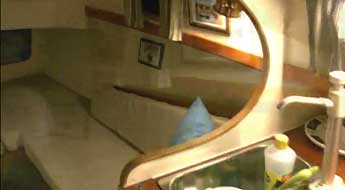
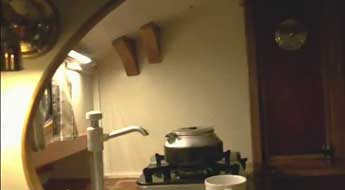

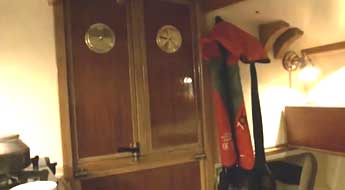


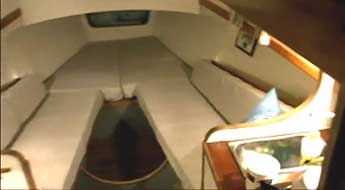
Segelmärke?
Om någon har lust att dekorera seglet med ett segelmärke på sin Sharpie, finns dessa att ladda ner från downloadsidan. Färgen kan anpassa efter båtens färger.
Gaffelversionen:

Loggertversionen:
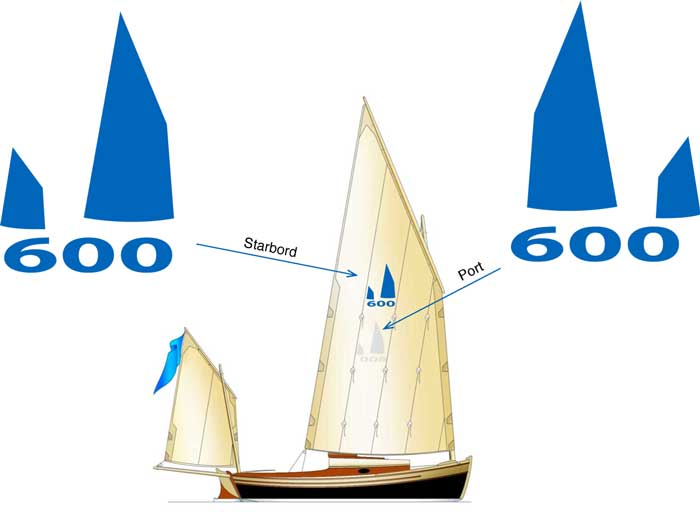
Sharpie 600 – bakgrund och historia
Sharpie 600 började som ett privat projekt - en idé om ett mycket enkelt, bekymmersfritt, billigt och behändigt sätt att tillbringa tid på havet. När ritningen började närma sig fullbordan utlyste Engelska Classic Boat en designtävling med ungefär samma kravspecifikation som den jag satt upp för mig själv.
Ritningarna skickades raskt in och hedrades med ett tredjepris trots sin tämligen oengelska uppsyn – ett centerbord och en mesanmast som inte sitter på centerlinjen är svårsmält för engelska traditionalister och kommenterades följdriktigt i juryns motivering:
Björn Thomasson's flat-bottomed 'weekender-for-two' appealed to me for its charming simplicity. At a personal level, I am not entirely comfortable with the assymetry of the off-center board and mizzen. Hang the rudder in a slot to allow for a central mizzen and centre the board and this little lug-rigged cat yawl complete with two-berth cabin, head and galley, would be just right fo a drying mooring. The high aspect ratio lug rig, certainly suits the little booat. Allowing for my personal prejudices, I gave it a third place.
Så om jag förstår det rätt: hade jag ritat den med mittmonterat centerbord (som hade gjort kajutan trång och svåranvänd) och hängt rodret i ett spår framför masten (betydligt mer komplicerad konstruktion, och ett roder som inte kan lyftas?) hade jag kanske vunnit hela tävlingen! De är knepiga, de där engelsmännen ;-)
I samma veva upptäckte jag att kajaker var ett ännu enklare sätt att tillbringa tid på havet, så prototypen kom att byggas av Wermlandia Båtproduktion, som ställde ut den på Båtmässan i Stockholm, där den drog till sig båtbyggares, journalisters och seglares intresse.
Hittills (sommaren 2021) är 51 ritningar sålda men min egen väntar jag fortfarande på – många kajaker har kommit emellan.
Sharpie eller inte?
Ibland blossar en debatt upp i amerikanska fora om vad som egentligen får kallas sharpie och vi som ritar moderna sharpies får oss en åthutning avseende vår brist på pietet gentemot historietraditionen. "Riktiga" sharpies var låga, långa och smala, flatbottnade med raka sidor, hopspikade av spåntat virke och försedda med två master med trekantsegel. De var snabba och betydligt mer sjödugliga än vad utseendet antyder. Utrymme för besättning var närmast ett skämt. Det blev inte ståhöjd i kajutan förrän skrovlängden var uppåt 15-16 meter – och även då såg kajutan ut som en friggebod på däck – men å andra sidan var det billigare att spika ihop en 16 meters sharpie än att bygga en 9 meters ordinär segelbåt. De flesta hade centerbord och man kunde segla ända in till stranden och kliva iland torrskodd. Båttypen anses ha uppstått i New Haven någon gång under tidigt 1800-tal, men letade sig ner längs ostkusten samtidigt som den anpassades för de nya farvattnen.
Min Sharpie 600 är för hög, för bred och för kort för att vara en riktigt sharpie, enligt den traditionella shapiens försvarare. Men jag är i gott sällskap (Phil Bolger, Bruce Kirby m fl). Seglarvärlden är numera full av för korta, för breda och för höga sharpies, medan de "riktiga" får betittas på museer. Fördelarna med skrovformen är alldeles för många för att inte exploateras.
Bilderna nedan visar hur en sharpie skall se ut om den skall vara godkänd av de rättrogna. Den här är från New Haven och slutet av 1800-talet.

En av de mest kända versionerna av sharpie-konceptet är Commander Ralph M. Munroes "Egret", en 8,6 meter lång sharpie, baserad på de klasiska New-Haven-båtarna men adapterad för nöjessegling i Florida. Den ritades i slutet av 1800-talet och har byggts i stort antal och inspirerat till åtskilliga efterföljare. Ritningar finns på Wooden Boat Store.
